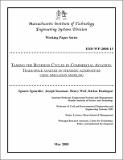| dc.contributor.author | Sgouridis, Sgouris | |
| dc.contributor.author | Sussman, Joseph M. | |
| dc.contributor.author | Weil, Henry Birdseye | |
| dc.contributor.author | Bozdogan, Kirkor | |
| dc.date.accessioned | 2016-06-02T20:47:42Z | |
| dc.date.available | 2016-06-02T20:47:42Z | |
| dc.date.issued | 2008-05 | |
| dc.identifier.uri | http://hdl.handle.net/1721.1/102869 | |
| dc.description.abstract | We investigate the effectiveness of strategic alternatives that are designed to dampen the cyclicality manifest in the commercial aviation related industries. The constituent enterprises of the commercial aviation system exhibit managerial and operational independence and have diverse value functions that often viewed the enterprises to view their competition as a zero-sum game. We argue that this need not always be the case; in the commercial aviation system both airline and airframe manufacturers constituents would benefit from a steadier influx of aircraft that counters the current situation that is characterized by relatively stable demand growth rate for air travel while airline profitability and aircraft ordering fluctuate intensely. In order to identify and evaluate the symbiotic potential, we use a system dynamics model of commercial aviation. After testing several individual strategic alternatives, we find that capacity management is key to cycle moderation for non-collusive strategies. Comparing faster aircraft deliveries to semi-fixed production schedules among other alternatives shows only the latter alternative to be Pareto efficient. | en_US |
| dc.language.iso | en_US | en_US |
| dc.publisher | Massachusetts Institute of Technology. Engineering Systems Division | en_US |
| dc.relation.ispartofseries | ESD Working Papers;ESD-WP-2008-15 | |
| dc.title | Taming the Business Cycles in Commercial Aviation: Trade-space analysis of strategic alternatives using simulation modeling | en_US |
| dc.type | Working Paper | en_US |
